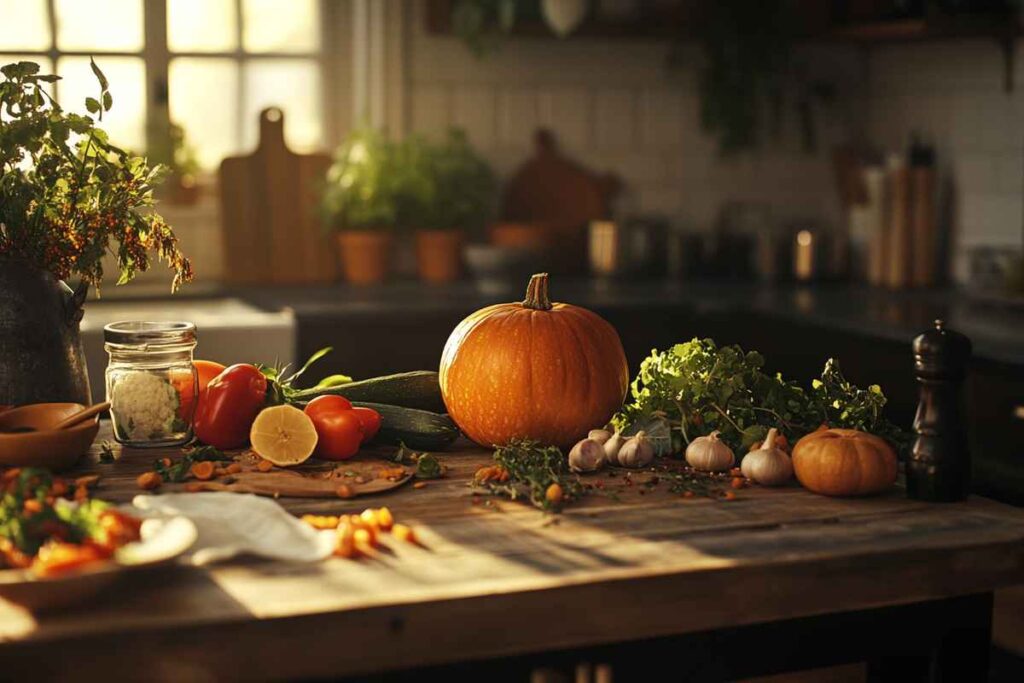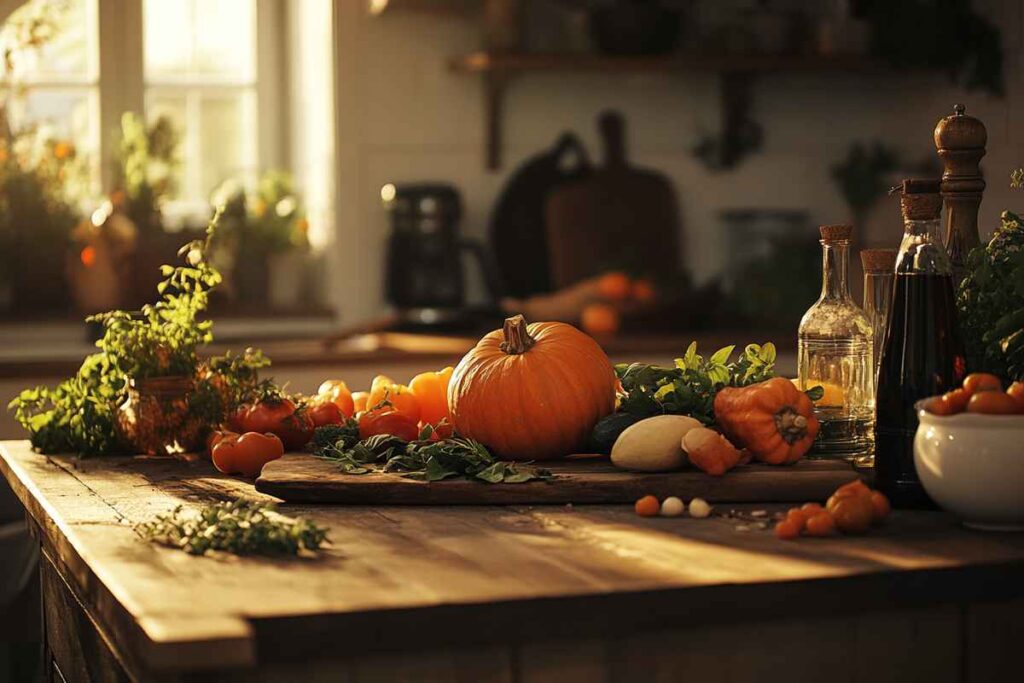The American name for kabocha squash, “Japanese pumpkin,” perfectly captures the essence of this beloved ingredient. Renowned for its creamy texture and sweet, nutty flavor, kabocha squash has become a staple in American kitchens. Its deep green skin and vibrant orange flesh not only make it visually appealing but also emphasize its connection to traditional pumpkins while showcasing its unique culinary versatility.
Introduction to the American Name for Kabocha Squash
The American name for kabocha squash, “Japanese pumpkin,” highlights its cultural ties and culinary uses in both Japanese and Western dishes. For instance, kabocha features prominently in hearty soups, roasted dishes, and even desserts, thanks to its naturally sweet flavor.
What is Kabocha Squash?
A Closer Look at Kabocha Squash
Kabocha squash is a winter squash variety celebrated for its dense, sweet, and starchy interior. It has a striking green rind with pale, speckled patterns and flesh that ranges from deep orange to yellow. This squash is often likened to buttercup squash for its similar sweetness and texture, but it stands out due to its complex flavor profile and versatility.
Key features of kabocha squash:
- Sweet and nutty taste, often compared to chestnuts or sweet potatoes.
- Thick skin that becomes tender when cooked (many recipes suggest eating it with the skin).
- Dense, starchy texture, making it ideal for soups, purees, and baked dishes.
American Name for Kabocha Squash: Common Names Explained
In the United States, the American name for kabocha squash—”Japanese pumpkin”—reflects its strong cultural and culinary associations with Japan. This squash is also occasionally labeled as “Asian pumpkin” or “green pumpkin” in grocery stores. For those unfamiliar with its unique characteristics, these names provide a simple introduction to its appearance and flavor.
The Cultural Significance of the American Name for Kabocha Squash
Origins and History
Kabocha squash originates from Japan, where it has been cultivated for centuries and is considered a staple ingredient. Its introduction to American markets was driven by the increasing popularity of Japanese cuisine, where ingredients like miso, tofu, and kabocha squash have found a growing audience.
The American name for kabocha squash—”Japanese pumpkin”—not only acknowledges its Japanese heritage but also simplifies its identity for American consumers. The squash’s prominence in dishes such as vegetarian Vietnamese sweet soups and tempura reflects its versatility and appeal.
A Global Favorite
Today, kabocha squash is a favorite in many international cuisines. Its adaptability allows it to star in both savory and sweet dishes. Whether it’s roasted as a side dish, blended into creamy soups, or baked into pies, kabocha squash is a go-to ingredient for chefs and home cooks alike.
Why Is Kabocha Squash Called Japanese Pumpkin?
A Practical Naming Convention
The term “Japanese pumpkin” serves as a practical way to introduce kabocha squash to the American market. Its shape, color, and texture are reminiscent of traditional pumpkins, while its unique taste sets it apart. This name helps shoppers unfamiliar with kabocha easily associate it with the familiar pumpkin family.
Marketing and Accessibility
Labeling kabocha squash as “Japanese pumpkin” also aids in marketing, especially for those exploring Asian ingredients. With its increasing presence in grocery stores and farmers’ markets, the American name for kabocha squash has become a bridge for introducing this delightful ingredient to a wider audience.
Culinary Uses of the American Name for Kabocha Squash

The American name for kabocha squash, “Japanese pumpkin,” emphasizes its versatility in the kitchen. This squash has found a home in a variety of dishes across cultures, making it a popular choice for both traditional and modern recipes. Its creamy texture, sweet flavor, and dense consistency make it a standout ingredient.
Popular Ways to Cook Kabocha Squash
Roasting and Baking
One of the most common methods of preparing kabocha squash is roasting. This technique brings out its natural sweetness while creating a rich, caramelized flavor. When roasted, the skin becomes tender enough to eat, adding a pleasant texture to the dish.
How to Roast Kabocha Squash:
- Cut the squash into wedges or cubes.
- Toss with olive oil, salt, and spices like cinnamon or paprika.
- Roast at 400°F for 25–30 minutes, turning halfway for even cooking.
Roasted kabocha squash is perfect as a side dish or as a topping for salads. For more ideas on how to cook kabocha, check out this detailed cooking guide.
Soups and Purees
Kabocha squash’s creamy texture makes it an excellent base for soups and purees. Its natural sweetness pairs well with savory spices such as ginger, curry, and turmeric. Popular recipes include:
- Vegan Vietnamese Sweet Soup: A comforting dish highlighting the squash’s inherent sweetness.
- Creamy kabocha squash soup blended with coconut milk for a velvety finish.
Pureed kabocha squash can also be used as a filling for ravioli, pies, or even added to smoothies for a nutrient boost.
Nutritional Benefits of Kabocha Squash
The American name for kabocha squash often goes hand in hand with discussions about health and wellness. This squash is packed with nutrients, making it a great addition to any diet.
Nutritional Highlights
Kabocha squash is rich in:
- Vitamin A: Supports vision, skin health, and immune function.
- Vitamin C: Boosts the immune system and promotes collagen production.
- Potassium: Helps maintain healthy blood pressure levels.
- Dietary Fiber: Aids digestion and promotes a feeling of fullness.
A Comparison with Other Squash
Compared to other squash varieties, kabocha stands out for its dense texture and sweet flavor. Its nutritional profile is similar to butternut squash but with a slightly lower carbohydrate content, making it a preferred option for low-carb diets. For those who want to explore other squash options, check out our guide to selecting the best squash for your recipes.
Exploring the American Name for Kabocha Squash in Fusion Cuisine

The American name for kabocha squash reflects its growing popularity in fusion cuisine. Its versatility allows it to blend seamlessly into a wide range of dishes, from traditional Asian recipes to Western-style comfort food.
Incorporating Kabocha into Western Dishes
Kabocha squash can be used as a substitute for sweet potatoes or pumpkins in many recipes. Its creamy texture makes it an excellent addition to:
- Mashed squash as a side dish.
- Squash risotto for a luxurious twist on a classic dish.
- Garlic Parmesan Chicken Pasta: Pairing roasted kabocha with pasta creates a hearty, satisfying meal.
Asian-Inspired Recipes
In Asian cuisine, kabocha squash is commonly used in soups, tempura, and curries. For instance:
- It can be sliced thin and deep-fried as part of a tempura platter.
- Added to a coconut curry, it absorbs the spices beautifully and enhances the dish with its sweetness.
- Try it in a Chinese squash recipe for a delicious vegan meal.
Tips for Selecting and Storing Kabocha Squash
The American name for kabocha squash often appears in grocery stores and farmers’ markets during the fall and winter seasons. Knowing how to choose and store this squash ensures you get the best flavor and texture.
Selecting the Perfect Kabocha
When choosing kabocha squash:
- Look for a firm squash with no soft spots or blemishes.
- The skin should be a deep green with occasional orange speckles.
- A heavier squash indicates dense, moist flesh.
Proper Storage
Store kabocha squash in a cool, dry place to extend its shelf life. It can last for weeks, making it a convenient ingredient to have on hand. Once cut, wrap it tightly and store it in the refrigerator for up to five days.
For tips on preparing and storing kabocha, see our article on how to handle kabocha squash without peeling.
Enhancing Your Meals with Kabocha Squash
The American name for kabocha squash has become synonymous with culinary versatility and nutritional excellence. Its ability to adapt to various cuisines makes it a valuable ingredient in any kitchen.
For more inspiration:
- Explore recipes with roasted kabocha squash to see how this ingredient shines in everyday meals.
- Try pairing it with unique flavors in fusion dishes for a creative culinary adventure.
This section illustrates how kabocha squash, or “Japanese pumpkin,” can elevate your cooking while offering numerous health benefits. From its rich flavor to its impressive versatility, it’s no wonder this squash has earned its place in both traditional and modern cuisine.
Frequently Asked Questions About the American Name for Kabocha Squash
The American name for kabocha squash, “Japanese pumpkin,” has sparked curiosity among home cooks and food enthusiasts alike. Below are concise answers to the most common questions about this versatile squash.
What Is Another Name for Kabocha Squash?
Kabocha squash is commonly referred to as “Japanese pumpkin” in the United States. This name highlights its origins and visual similarity to pumpkins, making it familiar to American audiences. Occasionally, it is also labeled as “green pumpkin” or “Asian pumpkin.”
Which Squash is Closest to Kabocha?
Buttercup squash is the closest in flavor and texture to kabocha. Both are sweet and starchy, making buttercup an excellent alternative when kabocha isn’t available. Explore buttercup squash as a substitute here.
Is Kabocha Squash the Same as Butternut Squash?
No, they are different. Kabocha is denser and sweeter with an edible skin, while butternut squash is smoother in texture and slightly milder in flavor. For recipe-specific advice, learn more about cooking kabocha squash.
Are Calabaza and Kabocha Squash the Same?
While both are winter squashes, calabaza is less sweet and has a milder flavor compared to kabocha. For dishes requiring the creamy sweetness of kabocha, consider buttercup or butternut squash instead.
What is a Substitute for Kabocha Squash in Soup?
Great substitutes for kabocha squash in soup include:
Buttercup squash: Closest in texture and flavor.
Sweet potatoes: Sweet and creamy, with a slightly different texture.
For more on preparing kabocha, visit this resource.
Can You Eat the Skin of Kabocha Squash?
Yes, the skin of kabocha squash becomes tender when cooked and is often eaten in recipes like roasted squash or curries. If you prefer peeling, read how to peel kabocha squash.
Conclusion: Celebrating the American Name for Kabocha Squash

The American name for kabocha squash, “Japanese pumpkin,” beautifully reflects the unique qualities of this versatile and nutritious vegetable. From its creamy texture and sweet, nutty flavor to its adaptability across global cuisines, kabocha squash has earned its place as a staple ingredient in both traditional and modern dishes.
Whether you’re roasting it as a side dish, blending it into soups, or incorporating it into fusion recipes, kabocha squash offers endless culinary possibilities. Its growing popularity in American kitchens is a testament to its flavor, health benefits, and ability to elevate meals. Embrace the “Japanese pumpkin” in your cooking and discover why it’s loved by chefs and home cooks alike!

